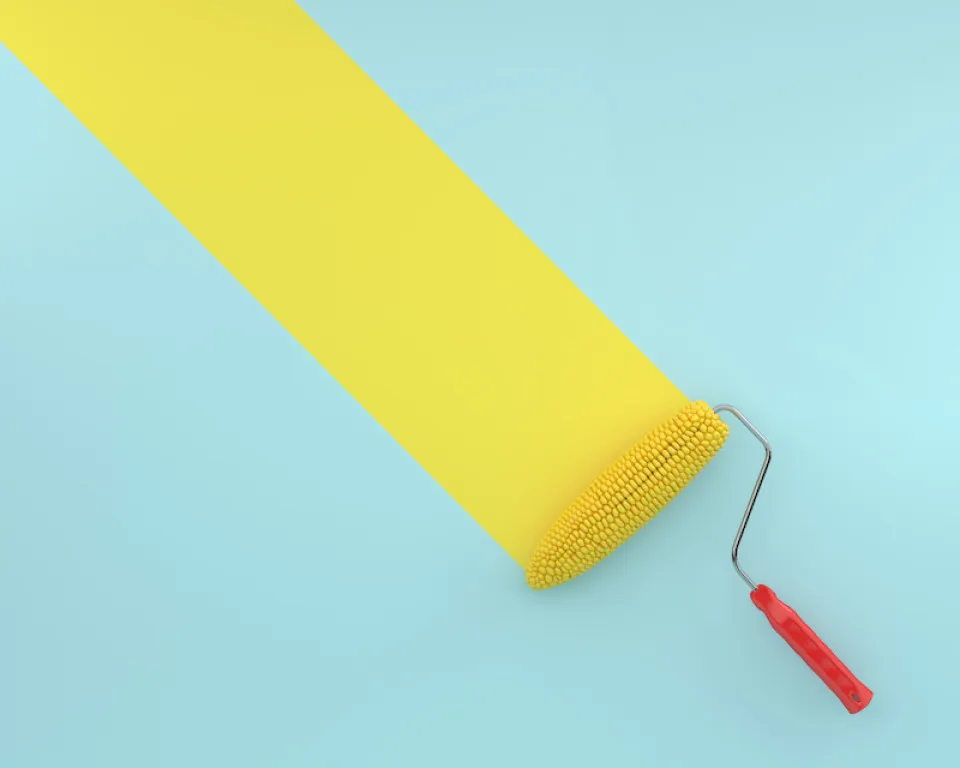Mengetahui teknik mengecat rumah merupakan salah satu cara untuk menyegarkan tampilan dan memberikan nuansa baru. Namun, sebelum memulai proyek pengecatan, penting untuk mengetahui cara menghitung kebutuhan cat tembok dengan tepat.
Hal ini dikarenakan perhitungan yang salah dapat mengakibatkan konsekuensi yang tidak diinginkan, seperti kekurangan cat yang menyebabkan pekerjaan terhambat atau kelebihan cat sehingga mengakibatkan pemborosan.
Artikel ini akan memandu Anda untuk mengetahui cara menghitung kebutuhan cat tembok dengan benar dan anti tekor pada biaya pembangunan atau renovasi rumah. Kami akan membahas langkah-langkah yang perlu diambil, mulai dari menghitung luas permukaan yang akan dicat hingga menentukan daya sebar cat dan jumlah cat yang dibutuhkan.
Cara Menghitung Kebutuhan Cat Tembok yang Benar
Untuk menghitung kebutuhan cat tembok, diperlukan beberapa tahapan. Tahapan tersebut mulai dari perhitungan luas permukaan, daya sebar cat, kebutuhan, dan lainnya. Berikut adalah penjelasan mengenai tahapan dari cara menghitung kebutuhan cat tembok:
1. Menghitung Luas Permukaan yang Dicat
Langkah pertama dalam cara menghitung kebutuhan cat tembok adalah mengukur luas area yang akan dicat. Dalam hal ini, Anda dapat menggunakan meteran untuk mengukur panjang dan tinggi setiap sisi dinding. Misalkan, untuk ruangan berukuran 4 x 5 m dengan tinggi 3 m, terdapat dua sisi dinding 4 x 3 m dan dua sisi lainnya 5 x 3 m.
Cara menghitung kebutuhan cat tembok ini diawali dengan menghitung luas setiap sisi dinding dengan mengalikan panjang dan tingginya. Misalkan, luas kedua sisi 4 x 3 m adalah 2 x (4 m x 3 m) = 24 meter². Demikian pula untuk kedua sisi 5 x 3 m, luasnya adalah 2 x (5 m x 3 m) = 30 m².
Total luas area yang akan dicat dapat diperoleh dengan menjumlahkan luas semua sisi dinding. Dalam contoh ini, total luasnya adalah 24 m² + 30 m² = 54 m².
Rumus cara menghitung luas permukaan kebutuhan cat tembok:
Luas area cat = (Panjang tembok 1 x Tinggi tembok 1) + (Panjang tembok 2 x Tinggi tembok 2) + (Panjang tembok n x Tinggi tembok n)
Contoh:
Luas area cat = 2(4 m x 3 m) + 2(5 m x 3 m) = 54 m²
Baca juga: Ide Kombinasi Cat Rumah Warna Biru Muda
2. Menentukan Daya Sebar Cat
Langkah kedua dari cara menghitung kebutuhan cat tembok adalah menentukan daya sebar cat. Daya sebar cat ini akan menunjukkan seberapa luas area yang dapat dilapisi dengan satu liter cat dalam sekali pengecatan. Nilai ini bisa berbeda-beda tergantung jenis cat yang digunakan. Pada umumnya, jika ada pertanyaan 1 kaleng cat tembok untuk berapa m², maka jawabannya adalah antara 10-12 m² per liter.
Sebagai contoh, mari asumsikan daya sebar cat tembok adalah 10 m² per liter. Untuk mengetahui berapa liter cat yang dibutuhkan untuk mengecat area seluas 50,5 m², maka Anda bisa menggunakan rumus berikut:
Luas Tembok yang Dicat / Daya Sebar Cat = Jumlah Cat yang Dibutuhkan
Dalam kasus ini, maka cara menghitung pemakaian cat tembok adalah:
50,5 m² / 10 m²/liter = 5,05 liter
3. Menghitung Kebutuhan Cat
Setelah mengetahui luas total tembok yang ingin dicat, langkah selanjutnya adalah menghitung kebutuhan cat tembok per meter persegi. Umumnya, kebutuhan cat tembok yang sering menjadi acuan adalah 10-12 meter persegi per liter. Namun, untuk mengantisipasi kekurangan, Anda sebaiknya menggunakan acuan terendah, yaitu 10 meter persegi per liter.
Sebagai contoh, jika total luas tembok dua ruang tidur adalah 178 meter persegi, maka kebutuhan cat temboknya kurang lebih 17,8 liter. Namun, perhitungan ini belum final. Untuk mengetahui langkah selanjutnya akan dilanjutkan pada pembahasan di bawah.
4. Menghitung Luas Pintu dan Jendela
Langkah selanjutnya dalam cara menghitung kebutuhan cat tembok pada sebuah bangunan adalah menghitung luas pintu dan jendela. Hal ini karena biasanya sebuah ruangan di bangunan memiliki pintu dan jendela. Untuk menghitungnya, Anda perlu perlu mengurangkan luas bukaan dari luas total dinding.
Misalkan, ruang A dan B memiliki pintu dengan ukuran sama, yaitu panjang 1 m dan tinggi 3 m. Kemudian luas pintu di setiap ruangan adalah 3 m², maka bisa disimpulkan bahwa total luas pintu di kedua ruangan adalah 6 m².
Apabila ruangan A memiliki tambahan jendela dengan panjang 3 m dan tinggi 2 m serta luas jendela A adalah 6 m², maka perhitunga luas dinding yang dicat adalah sebagai berikut:
Total luas dinding pada contoh ini adalah 190 m². Dengan mengurangi luas pintu dan jendela, didapatkan luas area yang perlu dicat:
Luas Dinding - Luas Pintu - Luas Jendela = Luas Area yang Dicat
Dari rumus cara menghitung kebutuhan cat tembok tahap perhitungan jendela dan pintu, maka:
190 m² - 6 m² - 6 m² = 178 m²
Baca juga: Cara Mengatasi Tembok Rembes
5. Konversi ke Kilogram
Langkah terakhir dari cara menghitung kebutuhan cat tembok adalah melakukan konversi ke kilogram. Hal ini karena cat tembok umumnya dijual dalam kemasan kaleng atau ember dengan satuan kilogram. Perlu diingat bahwa 1 liter cat tidak sama dengan 1 kilogram cat dan berbeda dengan air yang memiliki hubungan linear antara volume dan massa. Hal ini dikarenakan cat memiliki massa jenis cairan yang lebih berat.
Sebagai contoh, massa jenis cat rata-rata adalah 1,4 kilogram per liter. Untuk menghitung kebutuhan cat tembok per meter persegi pada dua kamar tidur, maka hitunglah volume cat yang dibutuhkan terlebih dahulu, kemudian kalikan dengan massa jenis cat.
Sebagai contoh, jika total luas permukaan tembok kedua kamar tidur adalah 18 m² dan Anda ingin menggunakan cat dengan daya labur 10 m² per liter, maka volume cat yang dibutuhkan adalah 18 m² atau 10 m² per liter = 1,8 liter.
Selanjutnya, Anda perlu mengalikan volume dengan massa jenisnya untuk mendapatkan kebutuhan cat dalam satuan kilogram. Misalnya, 1,8 liter x 1,4 kilogram per liter = 2,52 kilogram. Selanjutnya, bulatkan nominal tersebut ke atas menjadi 25 kilogram.
Perlu diingat bahwa angka ini hanya perkiraan. Kebutuhan cat yang sebenarnya dapat bervariasi tergantung pada tingkat porositas tembok, metode aplikasi, dan jenis cat yang digunakan.
Jika Anda ingin melapisi cat lebih dari satu kali, maka kalikan kebutuhan cat tembok dengan jumlah lapisan yang diinginkan.
Contohnya, jika ingin melapisi cat dua kali, maka kebutuhan cat tembok menjadi 25 kilogram x 2 = 50 kilogram.
Tips Hemat Cat Tembok
Setelah memahami cara menghitung kebutuhan cat tembok, selanjutnya Anda perlu mengetahui tips hemat penggunaannya agar tidak berlebih hingga menimbulkan kerugian. Berikut tips hemat cat tembok yang bisa diterapkan:
1. Pilih Cat Sesuai Kebutuhan
Di tengah banyaknya pilihan jenis cat dengan harga yang beragam, perlu diketahui bahwa memilih bahan bangunan ini secara tepat bukan hanya soal estetika, tapi juga investasi. Keputusan cermat tersebut dapat membantu Anda dalam menghitung kebutuhan cat tembok secara akurat, sekaligus menghemat anggaran.
Cat berkualitas tinggi, layaknya pelukis handal yang mampu mewarnai dinding dengan sempurna hanya dalam 2-3 lapis. Di sisi lain, cat berkualitas rendah bagaikan pelukis amatir yang membutuhkan 5-6 lapis aplikasi untuk mencapai hasil yang sama. Hal ini bukan hanya boros waktu dan tenaga, tapi juga menguras dompet karena membutuhkan lebih banyak cat.
Meskipun harga cat berkualitas rendah lebih murah di awal, pada akhirnya Anda akan mengeluarkan lebih banyak biaya untuk mencapai hasil yang sama. Karena itu, investasikan sedikit lebih banyak uang untuk cat berkualitas tinggi untuk menikmati hasil lebih indah dan tahan lama serta hemat pengeluaran dalam jangka panjang.
2. Ketahui Jenis Dinding
Mengetahui jenis dinding yang akan dicat merupakan langkah penting dalam menghitung kebutuhan cat tembok secara efisien. Hal ini dikarenakan jenis dinding yang berbeda memiliki tingkat penyerapan cat yang berbeda pula.
Dinding kosong tanpa cat dasar umumnya membutuhkan lebih banyak pelapisan dibandingkan dengan dinding yang sudah memiliki cat dasar. Hal ini berarti, Anda membutuhkan cat yang lebih banyak untuk mencapai hasil yang diinginkan pada dinding kosong.
Sebaliknya, jika Anda mengecat dinding yang sudah memiliki cat dasar, maka hal ini bisa menghemat penggunaannya sehingga membantu mengurangi tingkat penyerapan pada dinding.
Oleh karena itu, penting untuk mengetahui jenis dinding yang akan dicat sebelum membeli cat tembok. Dengan begitu, Anda dapat menghitung kebutuhan cat secara lebih akurat dan menghemat pengeluaran.
3. Aplikasikan Cat secara Efisien
Mengecat tembok dengan efisien membutuhkan teknik dan tips yang tepat. Anda dapat memilih teknik rol, semprot, atau kuas sesuai area yang ingin dicat. Kemudian, jangan lupa gunakan kuas untuk area sulit dijangkau rol. Dengan teknik yang tepat, Anda dapat menghitung kebutuhan cat tembok dengan lebih efektif dan mendapatkan hasil yang maksimal.
Itulah informasi mengenai cara menghitung kebutuhan cat tembok yang benar dan perlu Anda perhatikan. Tak hanya itu, artikel ini juga memuat tips hemat menggunakan cat tembok yang bisa digunakan untuk rujukan Anda. Dengan melakukan perhitungan ini, diharapkan keuangan tidak boncos selama melakukan pengecatan di rumah.
Perlu diketahui, sebelum melakukan pengecatan, tembok harus diplamir terlebih dahulu agar cat menempel dengan baik. Proses ini umumnya menggunakan cairan putih yang terbuat dari lem, kalsium, dan semen. Adapun semen yang digunakan untuk plamir adalah semen putih dengan kualitas tinggi agar hasil yang diperoleh dari pengecatan bisa sempurna.
Oleh karena itu, pastikan Anda menggunakan Semen Merah Putih Watershield sebelum melakukan plamir pada dinding. Semen Merah Putih Watershield merupakan produk semen premium untuk melindungi tembok dari jamur dan garam alkali yang dapat menyebabkan cat mengelupas dikarenakan lembap pada dinding.
Jadi, segera hubungi kami jika Anda ingin memesan Semen Merah Putih dalam jumlah besar sekarang juga!
Baca juga: Cara Mengatasi Dinding Lembap



